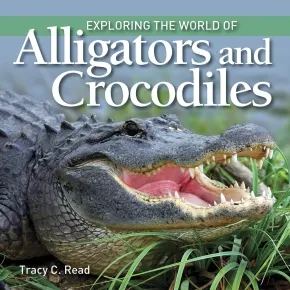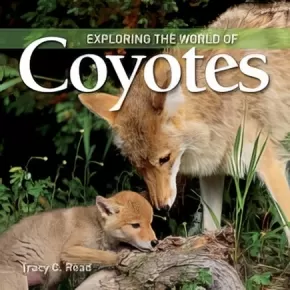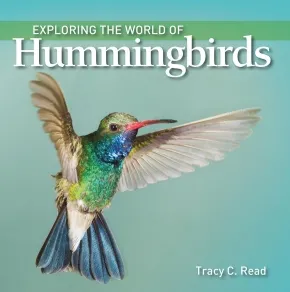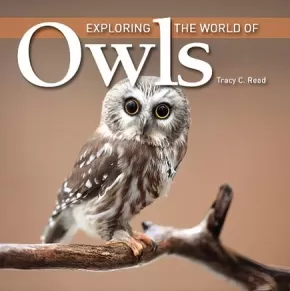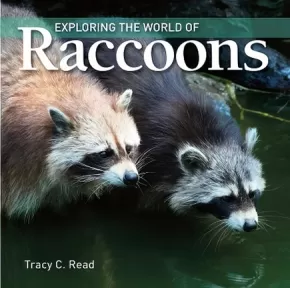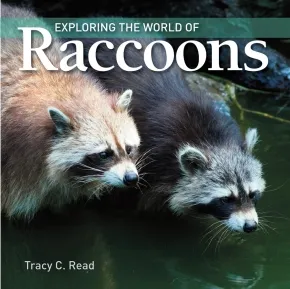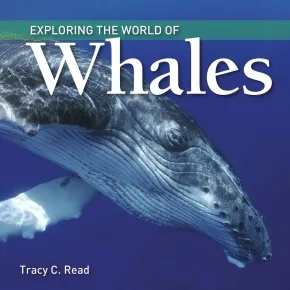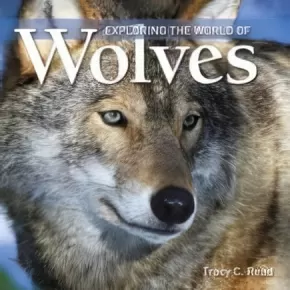Tracy C. Read
Tracy C. Read is an editor and writer who has a special interest in nature and the environment. She lives in Kingston, Ontario.
Kids Books (13)
Synopsis:
Silently suspended in water, with only their eyes, nostrils and ears breaking the surface, these members of the crocodilian family play a terrifying sit-and-wait game with their prey, striking with lightning speed, chilling accuracy and a deadly bite stronger than any other living creature. Their victims stand little chance once held in their strong jaws. Land-dwelling prey are equally at risk--crocodilians can walk, gallop and leap at high speed, making them among nature's fiercest predators.
The crocodile and alligator families descend from the reptiles that roamed Earth alongside the dinosaurs some 250 million years ago. Today, most of the land-dwelling crocodilians live in tropical lowlands, while the broad-snouted American and Chinese alligators have adapted to cooler temperatures.
In Exploring the World of Alligators and Crocodiles, young readers will learn about the crocodilians' life history, physical characteristics, courtship displays, communication strategies and family life. They'll also find out how these semiaquatic reptiles rely on their senses and speed to survive--and why humans should keep their distance.
Reviews
"There's plenty of nonfiction for elementary grades, but finding attractive nonfiction for secondary can be more of a challenge. The "Exploring the World of..." series answers that need. Crisp close-up photographs augment the clear, well-written text... Younger students would find much to enjoy in the photographs. Reader will learn about hummingbird history, anatomy, diet, and flight ability. Mating, nesting, and life cycle are briefly covered. A wide variety of hummingbirds are highlighted. The text is aflutter with interesting facts. An index is included... This is an eye-catching book suitable for secondary library shelves." — Teresa Bateman, Puget Sound Council for the Review of Children's and Young Adult Literature, August 2018
"The photography contained in Exploring the World of Alligators and Crocodiles is exquisite. The anatomical structure is detailed and diagrammed. Sensory data is displayed and courtship pictures and inset with young hatching. A crocodilian gallery features the variety of this order, from the Saltwater Crocodile and Cuvier's Dwarf Caiman to the American Alligator and Mugger Crocodile. The photographers portray a species that is dangerous, yet protected as its numbers decrease." — Judy Kraus, National Science Teachers Association, September 2017
Educator & Series Information
Recommended for ages 7 to 12.
The Exploring the World of... nature series was created for young readers who are eager to learn more about the wild creatures of the world. Each title contains beautiful photographs of the animals in their natural habitats and the highly readable text explores their daily lives and physical characteristics, how they make their homes, how they raise their young and what they eat.
Additional Information
24 pages | 8.00" x 8.00" | full color throughout, index | Paperback
Synopsis:
We watch bees buzzing from plant to plant in our gardens, yet apart from worrying about being stung, many of us don't give them another thought. But who are these flying insects, and what exactly are they doing in our backyards?
Exploring the World of Bees covers the differences in the social lives of bees and how they organize their families, their homes and their work. Young readers can learn that different bees have developed special physical adaptations -- from a body size so small they can't be seen in flight and keen vision to extra-long nectar-lapping tongues and convenient leg packs for carrying pollen. They'll also discover more about the many ways in which humans depend on bees, even while our activities increasingly put these precious pollinators at risk.
Series Information
This book is part of the "Exploring the World of..." series, a nature series produced especially for young readers who are eager to learn more about the wild animals they find especially appealing. The books are packed with facts and offer outstanding value. Clear text in large type and vivid photographs with explanatory captions describe the animals' physical attributes, and storylike narratives about their daily life -- where they live, what they eat, how they hunt, how they communicate, how they raise their young -- present a complete picture of each animal.
Additional Information
24 pages | 8.00" x 8.00"
Synopsis:
Powerful, sleek and designed to hunt and kill other animals, the cougar is a cat, right down to its remarkable sense of balance, retractable claws and single-minded approach to independent living.
Wherever this solitary hunter lives, it is a superior predator, using its stealth, timing and strength to ambush and overwhelm its prey, whether it's a tiny mouse or a 500-pound elk. Readers will learn about the cougar's special skills as a hunter and why it has the largest range of any wild land animal in North America. Illustrated with beautiful four-color photography, Exploring the World of Cougars is a lively, fact-filled introduction to this controversial cat.
Educator & Series Information
This book is part of the "Exploring the World of..." series, a nature series produced especially for young readers who are eager to learn more about the wild animals they find especially appealing. The books are packed with facts and offer outstanding value. Clear text in large type and vivid photographs with explanatory captions describe the animals' physical attributes, and storylike narratives about their daily life -- where they live, what they eat, how they hunt, how they communicate, how they raise their young -- present a complete picture of each animal.
Additional Information
24 pages | 8.00" x 8.00"
Synopsis:
Coyotes are wily, secretive and extremely adaptive -- what young reader wouldn't be fascinated?
Familiar to kids and adults alike through its many appearances in folk and popular culture, the multicolored coyote has the gray wolf to thank for its survival. As humans eliminated wolf populations across the continent over the last century, the coyote easily filled the gap. Today it is the most successful and most numerous large predator in North America. It makes its homes not only in the wild but increasingly in suburbs and even urban centers -- the coyote is wary of humans but is quite willing to enter the human world in pursuit of food.
The coyote has a curious blend of characteristics that it shares with its dog-family relatives, the wolf and the red fox. Like the red fox, it has graceful, catlike movements. Like the wolf, it can hunt in packs but may also hunt on its own or with a partner.
Exploring the World of Coyotes explains how the wily coyote achieved such great success, from its elaborate communication skills, mate selection and family life to its adaptive life skills and physical characteristics.
Educator & Series Information
This book is part of the "Exploring the World of..." series, a nature series produced especially for young readers who are eager to learn more about the wild animals they find especially appealing. The books are packed with facts and offer outstanding value. Clear text in large type and vivid photographs with explanatory captions describe the animals' physical attributes, and storylike narratives about their daily life -- where they live, what they eat, how they hunt, how they communicate, how they raise their young -- present a complete picture of each animal.
Additional Information
24 pages | 8.00" x 8.00"
Synopsis:
High flight with North America''s mighty eagles.
Only two kinds of eagles live in North America, the bald eagle and the golden eagle. These majestic birds belong to the same family and share many physical traits and behaviors, but there are also important differences between them.
In this fully illustrated introduction, young readers will discover why the bald eagle lives along the coastlines of oceans, lakes and rivers while the golden eagle prefers mountainous regions, prairies and plains. They''ll learn about the impressive nest-building skills of these two raptors and their courtship displays, mating patterns and fierce hunting styles.
Full-color photographs provide close-ups and action shots of these aerial performers, while the engaging text, sidebars and captions offer insights into the life history of two of the world''s most powerful winged predators.
Series Information
This book is part of the "Exploring the World of..." series, a nature series produced especially for young readers who are eager to learn more about the wild animals they find especially appealing. The books are packed with facts and offer outstanding value. Clear text in large type and vivid photographs with explanatory captions describe the animals' physical attributes, and storylike narratives about their daily life -- where they live, what they eat, how they hunt, how they communicate, how they raise their young -- present a complete picture of each animal.
Additional Information
24 pages | 8.00" x 8.00"
Synopsis:
The facts and fun of life as a fox.
With their catlike faces, big ears and fluffy tails, foxes appeal to youngsters, but children may not know that a fox can smell prey deep in the snow and that some can climb trees. Young readers will learn about the various fox species, such as red foxes, arctic foxes, gray foxes and swift foxes, and they will read about what it would be like to be a fox pup. Photographs of adult and young foxes in their natural habitats and sidebars with storylike content round out this rich portrayal of foxes in the wild.
Educator & Series Information
This book is part of the "Exploring the World of..." series, a nature series produced especially for young readers who are eager to learn more about the wild animals they find especially appealing. The books are packed with facts and offer outstanding value. Clear text in large type and vivid photographs with explanatory captions describe the animals' physical attributes, and storylike narratives about their daily life -- where they live, what they eat, how they hunt, how they communicate, how they raise their young -- present a complete picture of each animal.
Additional Information
24 pages | 8.00" x 8.00"
Synopsis:
There's no greater thrill than spotting one of these tiny birds in the garden, and young readers will be fascinated by how this avian machine works. Hummingbirds are the smallest birds in the world, but they exploit every advantage that comes with their modest size. Exploring the World of Hummingbirds is a fully illustrated introduction to the hummingbird's high-performance lifestyle.
Built for efficiency and fueled with high-energy nectar, this bird runs at a high temperature during the daytime, its heart beating 650 beats a minute, and its dense feathers keep it warm at night as it rests. Most impressive, however, are its skills as an aerial acrobat. Like a helicopter, it can move forward, backward and sideways. When feeding from a blossom, it can hover in midair and then turn and whir away at full speed -- all in two-tenths of a second.
Readers will find out how hummingbirds and flowers have evolved for their mutual success. They'll also discover intriguing facts about hummingbird biology, flight, mating and nesting behaviors, family life, migration, and just how a hummingbird achieves and maintains its dazzling, shimmering colors.
Reviews
"There's plenty of nonfiction for elementary grades, but finding attractive nonfiction for secondary can be more of a challenge. The "Exploring the World of..." series answers that need. Crisp close-up photographs augment the clear, well-written text... Younger students would find much to enjoy in the photographs. Reader will learn about hummingbird history, anatomy, diet, and flight ability. Mating, nesting, and life cycle are briefly covered. A wide variety of hummingbirds are highlighted. The text is aflutter with interesting facts. An index is included... This is an eye-catching book suitable for secondary library shelves." — Teresa Bateman, Puget Sound Council for the Review of Children's and Young Adult Literature, August 2018
"Provides a detailed description of these tiny birds ranging from 3 to 21 cm and weighing a mere 11 grams or less... The photography contained in Exploring the World of Hummingbirds is exquisite. The hummingbird appears in mid-flight on the cover, resplendent in all its colors. A gallery of hummingbirds illustrates the wide variety of pigmentation, from non-iridescent colors produced by chemicals to the iridescent ones that are structural. The anatomical structure is magnified and diagrammed. The search for nectar is even captured on the page." — Judy Kraus, Science Scope Magazine, December 2017
"An educational book written especially for young people ages 8-12. Eye-catching, full-color photographs of these beautiful, tiny, and energetic birds in flight, feeding, or raising their young fill this captivating browse... An index rounds out this choice pick for school and public library middle grade collections. Also highly recommended are the other titles in the "Exploring the World" series." — Midwest Book Review, November 2017
"This series has a different approach than typical animal books and goes beyond a basic introduction. The books provide the reader with another perspective and focus on different forms of survival tactics. Diagrams of the animals are presented describing different body parts and their functions. Another chapter discusses the natural talents of the animal... An extensive index is included. Recommended."--Library Media Connection, of the previous books in the series
Educator & Series Information
Recommended for ages 7 to 12.
The Exploring the World of... nature series was created for young readers who are eager to learn more about the wild creatures of the world. Each title contains beautiful photographs of the animals in their natural habitats and the highly readable text explores their daily lives and physical characteristics, how they make their homes, how they raise their young and what they eat.
Additional Information
24 pages | 8.00" x 8.00" | Paperback
Synopsis:
The haunting sound of its distant hoot may be as close as many of us ever get to an owl. But of the roughly 200 owl species worldwide, 19 make their homes across North America. These birds of prey display noticeable differences in size and markings, but they also share many physical traits and living skills.
How do owls capture prey and defend themselves? How are their wings designed for silent, gliding flight? How do owls conceal themselves from predators? Young readers will learn the answers to these questions and much more in the beautifully illustrated Exploring the World of Owls.
Educator & Series Information
This book is part of the "Exploring the World of..." series, a nature series produced especially for young readers who are eager to learn more about the wild animals they find especially appealing. The books are packed with facts and offer outstanding value. Clear text in large type and vivid photographs with explanatory captions describe the animals' physical attributes, and storylike narratives about their daily life -- where they live, what they eat, how they hunt, how they communicate, how they raise their young -- present a complete picture of each animal.
Additional Information
24 pages | 8.00" x 8.00"
Synopsis:
A glimpse inside the daily life of nature's masked bandits.
Children find the bandit-masked face and button nose of a raccoon irresistibly cute, and catching a glimpse of one in a neighborhood tree never fails to excite. Raccoons describes the natural history of these cousins of the panda bear and explains how that heritage helps them thrive in cities as well as in fields and woodlands. Color photographs of adults and kits in urban and natural settings give readers the chance to look more closely at these elusive creatures, and children will enjoy the amusing descriptions of the raccoon's antics and mischief. But Raccoons also shows youngsters why they shouldn't feed these brazen visitors and that, even though they share our cities and towns, raccoons will always be wild animals.
Educator & Series Information
This book is part of the "Exploring the World of..." series, a nature series produced especially for young readers who are eager to learn more about the wild animals they find especially appealing. The books are packed with facts and offer outstanding value. Clear text in large type and vivid photographs with explanatory captions describe the animals' physical attributes, and storylike narratives about their daily life -- where they live, what they eat, how they hunt, how they communicate, how they raise their young -- present a complete picture of each animal.
Additional Information
24 pages | 8.00" x 8.00"
Synopsis:
A glimpse inside the daily life of nature's masked bandits.
Children find the bandit-masked face and button nose of a raccoon irresistibly cute, and catching a glimpse of one in a neighborhood tree never fails to excite. Raccoons describes the natural history of these cousins of the panda bear and explains how that heritage helps them thrive in cities as well as in fields and woodlands. Color photographs of adults and kits in urban and natural settings give readers the chance to look more closely at these elusive creatures, and children will enjoy the amusing descriptions of the raccoon's antics and mischief. But Raccoons also shows youngsters why they shouldn't feed these brazen visitors and that, even though they share our cities and towns, raccoons will always be wild animals.
Educator & Series Information
Recommended for ages 7 to 12.
The Exploring the World of... nature series was created for young readers who are eager to learn more about the wild creatures of the world. Each title contains beautiful photographs of the animals in their natural habitats and the highly readable text explores their daily lives and physical characteristics, how they make their homes, how they raise their young and what they eat.
Additional Information
24 pages | 8.00" x 8.00" | Full-colour photographs throughout, index | Paperback
Synopsis:
The curious facts and exotic fun of the lives of seals and walruses.
The lifestyle of the seals that entertain at marine parks has little to do with how seals, sea lions and walruses actually survive in the wild. Exploring the World of Seals explains how these North American pinnipeds have adapted to live in two habitats, on land and in water. This ancient group of sea mammals comes in wildly different sizes, from the 100-pound ringed seal to the 3-ton elephant seal, and the range of their behaviors varies just as widely. With their streamlined bodies, insulating blubber or fur, flippers where other animals have limbs and long necks, these marine mammals are built to navigate the water in search of food, yet most of them court, mate and give birth on land.
How do seals and walruses regulate their body temperature? How do they see their prey and predators in the dim underwater light? What are the effects of massive oil spills on the survival of these species that have inhabited Earth for millions of years? Exploring the World of Seals provides these answers and many more.
Educator & Series Information
This book is part of the "Exploring the World of..." series, a nature series produced especially for young readers who are eager to learn more about the wild animals they find especially appealing. The books are packed with facts and offer outstanding value. Clear text in large type and vivid photographs with explanatory captions describe the animals' physical attributes, and storylike narratives about their daily life -- where they live, what they eat, how they hunt, how they communicate, how they raise their young -- present a complete picture of each animal.
Additional Information
24 pages | 8.00" x 8.00"
Synopsis:
With sturdy, streamlined bodies, outfitted with insulating blubber, flippers, tail flukes and fins, whales -- all known as cetaceans -- are built for life in the water. In Exploring the World of Whales, we meet the baleen whales and the largest members of the toothed whales, including the killer whale, the biggest of the dolphins. These marine mammals range in size from the 108-foot-long (33 m) blue whale to the barely 9-foot-long (2.7 m) dwarf sperm whale while boasting a range of distinctive physical traits, including the sperm whale's gigantic head, the humpback's barnacle-covered body and outsized flippers, and the narwhal's eight-foot-long tusk.
Young readers will learn the difference between the baleen and toothed whales and how these differences affect habitat, diet and behaviors. They'll discover how whales communicate with one another across vast stretches of ocean, how some cooperate to raise families and hunt their prey, and how some are capable of remarkable feats of migration and deep diving. A lively, fully illustrated introduction to some of the planet's most intelligent species, this book also addresses the ongoing risks to whale populations.
Reviews
"Crisp photographs accompany interesting text that provides fascinating information about both baleen and toothed whales of many varieties. There's information here about diet, habitat, communication, behavior, and social interactions." — Teresa Bateman, Puget Sound Council for the Review of Children's and Young Adult Literature, August 2018
Educator & Series Information
Recommended for ages 7 to 12.
The Exploring the World of... nature series was created for young readers who are eager to learn more about the wild creatures of the world. Each title contains beautiful photographs of the animals in their natural habitats and the highly readable text explores their daily lives and physical characteristics, how they make their homes, how they raise their young and what they eat.
Additional Information
24 pages | 8.00" x 8.00" | full color throughout, index | Paperback
Synopsis:
The wild, wary gray wolf.
The largest wild member of the dog family, the gray wolf stalks much larger mammals, such as the elk, caribou and moose. How does it succeed? Built to run, the long-legged wolf on the hunt uses its powerful sight, hearing, smell and physical strength. But, like the domestic dog, the wolf is a social animal: it lives in a pack.
In this fully illustrated introduction, young readers will learn how group living makes sense for the wolf, allowing it to form strong bonds and share tasks like rearing its young, finding food and communicating over long distances. They''ll also find out how habitat destruction, poisoning campaigns and hunting have reduced gray wolf populations in much of North America.
Full-color photographs provide close-ups and action shots, while the engaging text, sidebars and captions tell the life history of an animal that researchers agree has one of nature''s most engaging personalities.
Educator & Series Information
This book is part of the "Exploring the World of..." series, a nature series produced especially for young readers who are eager to learn more about the wild animals they find especially appealing. The books are packed with facts and offer outstanding value. Clear text in large type and vivid photographs with explanatory captions describe the animals' physical attributes, and storylike narratives about their daily life -- where they live, what they eat, how they hunt, how they communicate, how they raise their young -- present a complete picture of each animal.
Additional Information
24 pages | 8.00" x 8.00"

